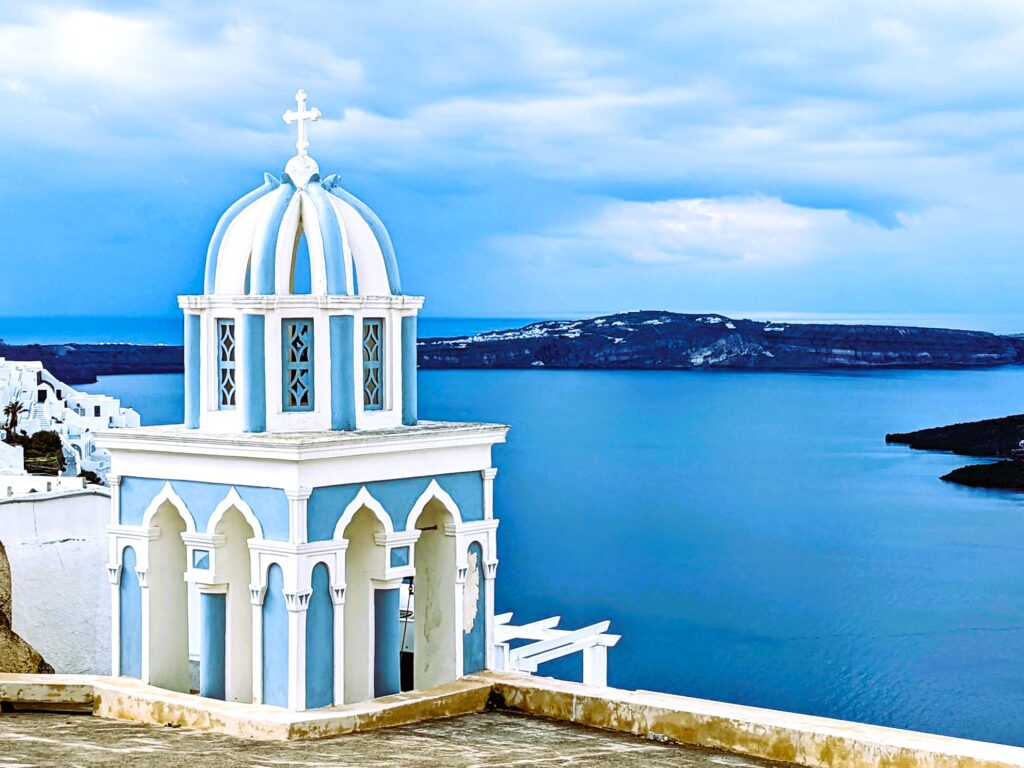
Santorini All to Ourselves
When we think of Santorini, our minds often drift to images of crystal-clear waters, sun-kissed beaches, and dazzling sunsets against the backdrop of white-washed buildings perched on red cliffs.
While these images certainly capture the essence of this Greek paradise during the summer, Santorini in winter offers an entirely different, yet equally enchanting experience. With very few tourists, the off-season reveals a side of the island that few venture to witness. We spent a week last March on the beautiful Greek island, and even though a lot of businesses were still closed, or just getting ready to open for the season, and it was still cold (damn cold actually!), we loved getting to see Santorini, seemingly like we were the only ones there.
Exploring the island from Oia to Exomitis, and every town and beach in between, allowed us to maximize how much we saw of the gorgeous island, which was perfect for this trip.


Unique Local Experiences
Visiting in March not only allowed us to explore the island at a great price but also provided us with the opportunity to engage and interact more intimately with Santorini’s full-time residents. We ate at multiple restaurants where all the patrons knew the staff well, and they were gracious enough to welcome us into their conversations.
As we found out, the winter season also introduces a whole new culinary experience on the island. As the demand from tourists decreases, restaurants shift their focus to heartier and more traditional Greek dishes, such as savory soups and stews.
Lower Costs and Availability
For budget-conscious travelers, visiting Santorini in winter can be a blessing. Accommodations, availability, and pricing of ferries and local activities come at significantly lower prices compared to peak tourist seasons, making it an ideal time to explore this stunning island without breaking the bank.
Moreover, finding available reservations becomes a whole lot easier, allowing you to have the luxury of choosing a nice hotel at a fraction of the cost. Our hotel overlooking the Caldera cost a third of what it would have been a couple of months later. Again, it was chilly, and we weren’t hanging on the beach, but we were already in Greece, so we decided to take advantage of seeing Santorini in a unique way at a bargain price. We tasted Santorini wine, we walked the island, and just enjoyed a different experience on this beautiful island.



A Prime Spot with an Iconic View
We stayed in Imerovigli, where we were treated to one of the best views in the world. Located above Skaros Rock and seemingly perched high in the sky, Imerovigli provides the perfect view of Santorini’s famed caldera.
Cut by at least four partially overlapping calderas, the oldest of which dates back nearly 200,000 years, the current caldera was formed about 3,600 years ago during the Minoan eruption. It’s really hard to compute how dramatic and amazing it is, even when you’re staring right at it.
In addition to the epic view, the architecture of Imerovigli is quintessential Cycladic style, including the church of Ai-Stratis in the center of the village and the Monastery of Saint Nikolaos.
Even if you’re not staying in Imerovigli, it’s a must to walk through and enjoy the character of the neighborhood while taking in the incredible views. It’s an easy walk from Fira, the capital of Santorini, which is a really fun town with great restaurants, cafes, and bars.
Or if you’re really adventurous, take the Fira to Oia walk. With a little detour, you can go right through Imerovigli, and depending on how many times you stop to gawk and snap photos of the caldera, it should only take you a couple of hours.
Another great vista from the neighborhood is of Skaros Rock. A stunning shape that was formed from volcanic activity some ridiculous amount of years ago, the rock still has the remains of a 13th-century Venetian castle.
Lots of Options
When visiting Greece in the colder months, you’ll definitely want to bundle up. This is especially true if you’re staying in a part of the island where the wind can pick up and be quite brutal. But if you still find it hard to warm up on frigid nights, as we did, especially in one of the coldest winters Greece has had in decades, you have many other options to turn to.
Ouzo, a dry anise-flavored aperitif made from neutral spirits after going through a process of distillation and flavoring, is a staple and widely consumed in Greece. It is best served with ice and water in a slim glass. When the ouzo touches the ice in the glass, or if you add water, the Ouzo will turn cloudy, which adds to the allure as you sip.
Tsipouro and Raki are also very popular (more so nowadays than Ouzo with younger Greeks), and they are similar as they are produced from pressed grapes through distillation. The main difference between the two is that Tsipouro is distilled twice, while Raki, also known as Tsikoudia, is distilled only once.
Construction in Santorini
You think your recent remodel or new pool was a nightmare? Try doing construction work in Santorini. No thanks. Just getting the materials for the work to the island is expensive, let alone moving all of it up the hill on centuries-old narrow walkways. And we haven’t even discussed the electrical and plumbing. These guys were making it happen though, and if you’ve seen some of the luxury accommodations in Santorini, it obviously can be done. I just wouldn’t want to see that contractor bill.
← The pool they were putting in over the Caldera had two guys strapped in hanging off the side.
The good news is, it appears labor is cheap as long as you have a lot of hay. →


